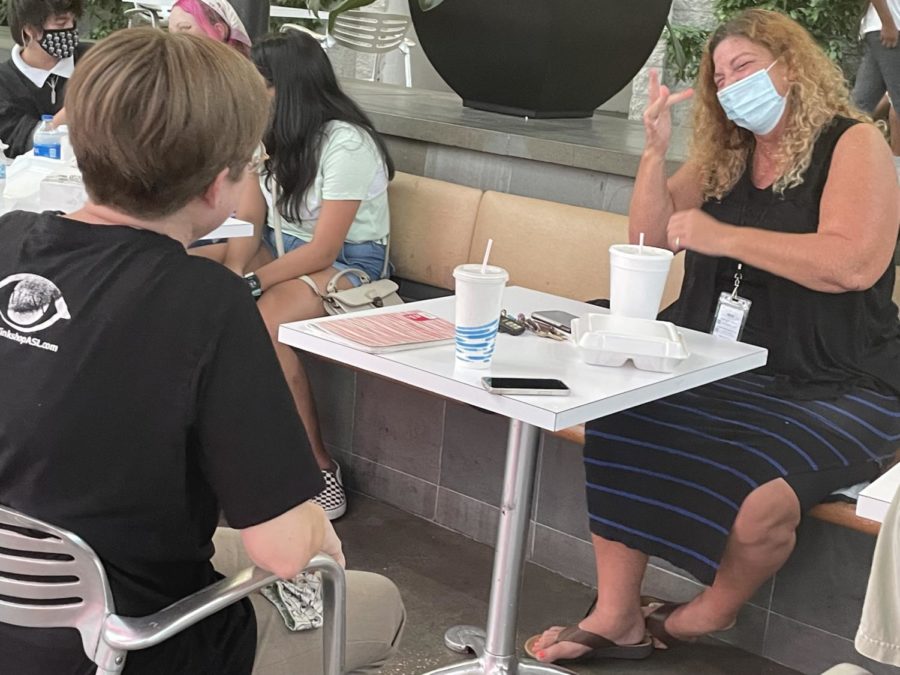No talking. No conversation. No sound at all, just hand gestures and facial expressions to communicate and hold a conversation. At the lower food court in the Oviedo Mall on Sept. 14, the American Sign Language program held a silent dinner that lasted from 6 p.m. to 7:30 p.m., where deaf and ASL students were encouraged to only use sign language while sharing dinner together.
Originally, silent dinners were hosted on the first Tuesday of every month, but with the outbreak of COVID-19, the tradition was temporarily put on hold. Not counting the past year, ASL teacher Barbara Chaves has been hosting these dinners for almost 20 years.
“I think it’s very important for the students to have a safe place to practice in the community and be able to interact with deaf people and other students learning ASL,” Chaves said.
As for her students, the silent dinner is an opportunity to interact with other ASL members. Senior Bella Knowles, the president of the ASL Honor Society, hopes to connect with the younger students in ASL classes I and II.
“I think it’s really important for the younger ASL kids to be able to communicate in an actual environment where they have to,” Knowles said.
Knowles is aware that most ASL I and II students do not sign outside of class, so she hopes the silent dinner will give them the chance to do so. Senior Michaela Maschhoff intends to use the dinner as a way to connect with more students who share the same passion.
“I hope through this I can make more friends who know ASL, who can help me become better,” Maschhoff said.
Although Maschhoff originally just took the class for the credits, they fell in love with the language as they learned more about deaf culture.
“The idea of being proud of who you are really inspired me and really moved me,” Maschhoff said.
For both the teachers and students, ASL goes far beyond the classroom. It has made a profound impact on their lives, not only teaching them more about the deaf community and sign language, but helping them grow together
“I found a new respect for people who are deaf. And for people who become deaf and for interpreters, all these people who are involved in this amazing community,” Maschhoff said.
Tolerance and appreciation of others who might not be like them is just one lesson Maschhoff has learned in the class. Learning about how the deaf are not disabled, but take pride in who they are drew Maschhoff into the language, just as Chaves was years ago.
“ASL is my passion. I love to watch the students grow and I love to watch the students begin to enjoy and cherish the language as much as I do,” Chaves said.
Silent dinners also play a role in this, creating a bond between students who share a passion for the language, and, as Chaves likes to put it, an ASL family.
“The silent dinner creates a family, it creates closeness, and a bond. It also gives the students confidence and gives the students a feeling of achievement,” Chaves said.
Since taking her first ASL class in her freshman year, Knowles feels she has developed this confidence throughout the years.
“I’ve definitely become a lot more outspoken…I’m willing to go out of my shell a lot more often because it’s taught me how to do that and be comfortable with myself doing it,” Knowles said.
Just as Knowles gained more self-assurance, Chaves hopes this confidence will encourage her students to continue with their ASL studies, as well as provide accessibility to the deaf community.
“It might be that a deaf person might go into the supermarket and one of my students will be there and recognize that that person’s deaf and they might sign, ‘Hi how are you?’ and the deaf person will feel very, very thrilled and feel welcomed and feel like they have accessibility to an everyday place where normally, they wouldn’t have it,” Chaves said.
The next silent dinner is scheduled for Tuesday, October 5, and will take place on the first Tuesday of every month.
This story was originally published on Hagerty Journalism Today on September 16, 2021.




































